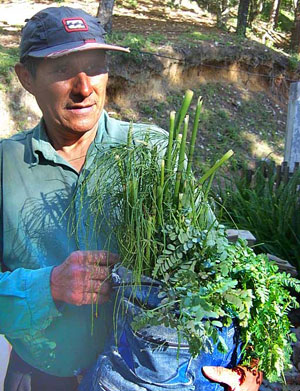Excerpts from Jim Conrad's
Naturalist Newsletter
from the December 24, 2007 Newsletter issued from Yerba Buena Clinic just outside Pueblo Nuevo Solistahuacan, Chiapas, MÉXICO
about 1740 meters in elevation, ± LAT. 17° 11' 27"N, LONG. -92° 53' 35"W
DON JESÚS'S BLUE CORDUROY BAG
Several local men are employed at Yerba Buena establishing a blackberry plantation. Each afternoon they come to my dwelling, an abandoned ruin of a former duplex, to store their tools overnight. The other day as they were going home I saw that one of them, Don Jesús
(pronounced heh-SOOS) carried a blue corduroy bag absolutely stuffed with plants he'd picked for taking home. Below, you can the Don and his stuffed bag .

The thick-stemmed plant on the left is one of the horsetails, genus EQUISETUM. Horsetails are spore- producing "fern allies," considered to be very primitive plants. During the Mississippian Period over 300,000,000 years ago horsetails were dominant land plants. Later gymnosperms arose and largely displaced the Earth's forests of giant horsetails.
A close-up of the other plant in the Don's bag is shown below.

These plants are sometimes called Leaf-flowers. They're in the genus PHYLLANTHUS. In the old days Phyllanthus was placed in the Euphorbia Family but recent genetic studies indicate that it's such an unusual genus that it deserves its own family, the newly constituted Leaf- flower Family, or Phyllanthaceae.
One unusual thing about leaf-flowers is that their leaves line up opposite one another along the stem and in the same plane, causing the leafy stem to look like a Black Locust's pinnately compound leaf. In the picture you can see that the plant's ultimate sections are leafy stems instead of pinnately compound leaves, however, because flowers arise at the base of each leaf. Flowers never occur at the base of compound leaf leaflets. When leaves line up opposite one another in the same plane they're said to be two-ranked, or "distichous." The effect can be pretty, as shown below:

Our leaf-flower species is common on the moist, semi- shaded floors of woods. Twelve Phyllanthus species are listed for Chiapas, but Phyllanthuses range from being fragile-looking herbs like this one to fair-sized trees. You may recall my telling about the Yucatan's Grosellas, which are small trees producing acidy fruits. That species is often known as Phyllanthus acidus.
Phyllanthus caroliniensis commonly occurs in much of the US Southeast and is known to extend southward all the way to Argentina. I wouldn't be surprised if Don Jesús's plants are that species. You can read about P. caroliniensis and see fine pictures of its flowers on the species' page at MissouriPlants.Com.
Don Jesús called his Phyllanthus "Quiebrapiedra," which means "break-rock." He claims it'll break up kidney stones.